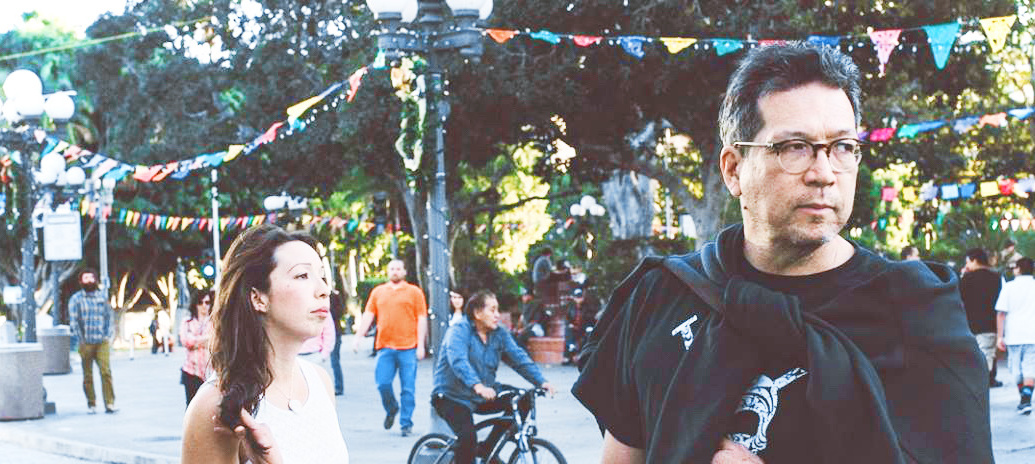Sesshu and his daughter at Placita Olvera in Los Angeles (Photo: Lindsay Bolling)
Author/educator/activist Sesshu Foster has dedicated his life to enriching and expanding the lives of those in his community.
By Athena Asklipiadis, Contributor
When thinking about East LA, what first comes to mind? Is it a gritty, rough neighborhood scene?
A tasty taco stand? Or, do you smirk thinking about the comedy of Cheech & Chong? Literature, poetry and the arts are not likely a first thought when thinking about that part of Los Angeles thanks to the media and Hollywood, but for years, author/educator/activist Sesshu Foster has blessed the literary world with a rare look at the area through the eyes of a Hapa Japanese American.
Growing up in East Los Angeles during the height of the Chicano movement, Foster naturally gravitated toward writing about his hometown, the various cultures there and the impact of gentrification through the narratives of everyday residents. And to complement Foster’s artistic endeavors is his commitment to local youth and community issues.
Before Foster even considered a career in the arts or education, his parents had built the foundation of a truly multicultural and creative home. Foster is the eldest of seven children born in Santa Barbara, Calif., to a Japanese American mother and Caucasian father.
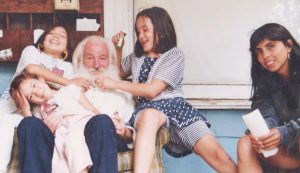
Sesshu’s father, his children, niece and Sesshu’s wife. (Photo: Sesshu Foster)
His parents were both former art students, and because his father followed Zen Buddhism, they had a Zen wedding in the hills of Santa Barbara. His father spent his GI Bill to study not only art but also spent his time following 1950’s white cross-cultural thinkers such as Alan Watts and Gary Snyder, as well as the Zen lectures by D. T. Suzuki.
Unlike his father, Foster’s mother and his Japanese American side of the family were less connected to Buddhism, as most of them followed Christianity. His mother was also from a large family, as she was one of 10 children born in California with humble and tragic beginnings. Sadly, in the 1930s prior to World War II, three of Foster’s mother’s siblings died from Tuberculosis.
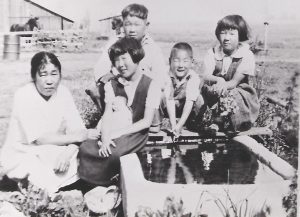
The Ogawa family at Arroyo Grande on the Central Coast of California in 1928 (Photo: Courtesy of Sesshu Foster)
“The JA side of my family was from the Central Coast from Arroyo Grande. … They were farm workers who were barely getting by, as far as I could tell. … When the war hit, they lost whatever little they did have,” Foster recalled.
Foster’s mother and family braved living in the horse stalls at Tanforan Racetrack before being transferred and incarcerated during World War II at the Poston War Relocation Center in Arizona.
At the conclusion of WWII, Foster said his family had the help of the Methodist Church to get back on their feet. Like many Japanese churches and temples at the time, they housed the formcer incarcerees. Some of Foster’s family lived temporarily in a fellowship house for $30 per month, which was a three-story dormlike facility that had communal showers and bathrooms, as well as hot meals. Following his family’s stay there, they later moved to the City Terrace neighborhood of East LA.
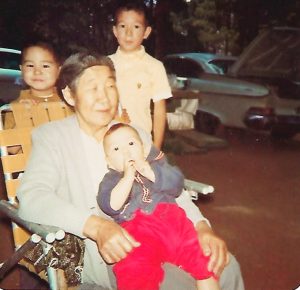
Sesshu’s maternal grandmother with his siblings and cousin (Photo: Courtesy of Sesshu Foster)
Decades after his extended family had been settled for some time in East LA, Foster, his mother and his siblings joined his maternal family there. They moved from Santa Barbara to City Terrace following Foster’s parents’ divorce when he was just 8 years old. He shared that his family lived on one hill, and his uncle’s family and kids lived on another.
One of Foster’s most well-known works, “City Terrace Field Manual,” is a collection of poetic vignettes that tells the stories of various characters from his eastside Los Angeles neighborhood of City Terrace. At the time he grew up there, during the 1960s and ’70s, the community was a majority Japanese and Mexican with a sprinkle of Chinese and Jewish inhabitants.
Foster grew up mostly in a JA-cultured home. It revolved around family and church activities. His family attended Union Church (the current location of East West Players and the David Henry Hwang Theater) in Little Tokyo. His childhood was filled with memories of church picnics and basketball. But, he explained that was mostly his peripheral experience.
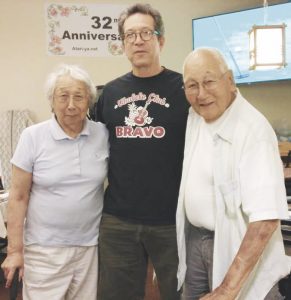
Sesshu with his mother and paternal uncle (Photo: Courtesy of Sesshu Foster)
Attending Wilson High School and having friends from the multiracial City Terrace area exposed Foster to a great deal of Latino culture as well. His interest in becoming a creative stemmed from being brought up by parents who were always interested in writing and avid readers. His family valued arts and culture, and his father was very fond of poetry as well.
Foster remembers many childhood trips to the City Terrace Public Library with his mother, carrying stacks of books home with him to read. This love of reading flourished and as a teen, he often spent time quietly writing, drawing and reading.
“Throughout high school. that’s what I did in class when I was bored. … Instead of paying attention to geometry, I would draw or write in my own notebooks,” he recalled.
His teacher combated his habit by taking his pens away; later, Foster said, his teacher took the whole notebook and made him sit at the front of the class so that he could focus on his math lessons. However, this punishment did not stop his love for the arts — it likely just fueled it.
In addition to Foster’s admiration for creative writing and art, he was also interested in pursuing a career in education. Following the footsteps of his mother, who was a sixth-grade teacher in East LA, he and four of his six siblings would go on to also become educators like her.
Foster first applied for a teaching job with the Los Angeles Unified School District, but made it a point to express that he wanted to teach in his hometown area.
“I told them that I only wanted to teach in East LA because that’s where I’m from,” he said. “I felt like I wanted to give back to my community … and I had ideas on how literature and composition could fit the needs of the students there.”
With Foster’s expression of that desire, he was shot down rather than embraced during the interview, as the administration personnel told him that they could not accommodate his wishes and that he would only be placed in schools of their choosing. Foster left being told he would not be a good fit and was basically turned away.
Sitting on a nearby bench outside of the interview location, a random man approached him. He asked if Foster was there looking for a teaching job. As fate would have it, the man asking turned out to be the principal of Hollenbeck Middle School, a school in the Boyle Heights neighborhood of East LA.
After a conversation with him, Foster was quickly offered a teaching job on the spot, and he would then remain on the faculty there for the next seven years.
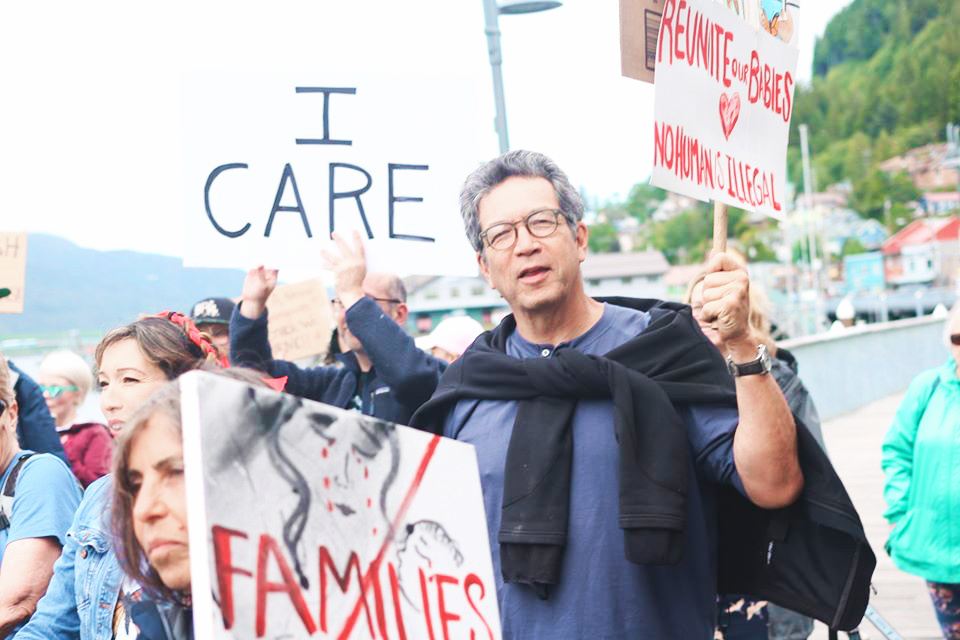
Sesshu, along with his wife and daughter, demonstrating against child separation (Photo: Courtesy of Sesshu Foster)
During his time at Hollenbeck, Foster’s teaching career expanded into roles as a department chair, union chair and chair of the gifted program with the school. He later took an offer from writer and Loyola Marymount University literature professor Ruben Martinez to be a liaison for a new afterschool writing program.
This was a busy time for Foster as a writer, teacher and as a chair in multiple areas; he also was a new father. He recalls juggling his full-time work with book writing and shuffling his kids to and from soccer practice. But despite all the obligations and packed schedule, Foster helped the new afterschool poetry club thrive and expand.
“I saw that poetry could change kids’ lives,” Foster said. His largely fixed, local-bound students in Boyle Heights grew up not having the means to do much outside of their neighborhood. Most of the students’ parents were limited by not having the money or time to take their kids places or expose them to the arts. But soon, the poetry club Foster and Martinez started got the students invitations for public poetry readings on KPFK radio, at the local mariachi festival and even caught the eye of Spanish-language newspaper La Opinion, who interviewed them.
Through the years, many kids who participated in the program ended up receiving scholarships for summer performance programs at California State University, Los Angeles, and CalArts. Some even landed summer internships at the University of California, Los Angeles. With Foster’s dedication and leadership, the program both opened up doors and also gave the children confidence as individuals. They learned to write and perform their poetry, which gave them the valuable experience of public speaking at a young age.
Foster taught at Hollenbeck Middle School from 1985-92 before taking a break to earn his MFA in degree in fiction writing at the University of Iowa. After completing his degree, Foster returned to teaching, this time at Francisco Bravo Medical Magnet High School in Lincoln Heights. He remained on the east side, teaching there until his retirement this year.
Having had a teaching career that spanned more than 30 years, Foster has seen a huge change in the accessibility to diverse stories. When he first began teaching, Foster recalls there was little to no Asian or Chicano literature in classrooms.
Most diversity in writing in the 1980s and prior to that came from African American writers from the East Coast. There was “no cultural representation in literature that was directly related to students in East LA,” stated Foster. This disparity propelled him into action.
“As a teacher, that was part of my intention … to directly relate to students.” And relate to them he did. Foster’s careers in teaching and writing both reflect that direct intention to create change by increasing diversity in storytelling.
Foster credits female writers such as Maxine Hong Kingston and Sandra Cisneros for paving the way for creatives like him.
“These women writers of the late ’70s and early ’80s really broke open representation across the board for all of us on the West Coast in an unexpected way,” he explained.
He went on to say it never seemed possible growing up until he saw it happen with them. But the writers that most inspired him were those who “went against the grain and chose smaller publishers,” he said.
Among his favorites were the beat writers from City Lights, cross-cultural writers such as Alan Ginsberg, Gary Snyder and Kenneth Rexroth, as well as local names such as Luis J. Rodriguez, Wanda Coleman from South Central Los Angeles and Charles Bukowski from Hollywood.
Foster also enjoyed LA writers who were able to represent their communities. He liked the idea that many of these writers showed what could be done locally without needing to be published by the large New York publishing houses. They paved their own road without needing the big publishers in tow to find success. Foster purposefully followed that route, printing with publishers like Kaya Press and, most recently, City Lights.
Now retired from teaching, Foster has not slowed down one bit. Foster, who has a wife and three adult daughters, spends his time now writing novels and giving collegiate talks. His most recent speaking engagement was during the pandemic, where he spoke to grad students and professors from the University of Texas at San Antonio virtually via Zoom.
Foster also uses his voice as an activist, most recently protesting for immigrant rights and against the conduct at the ICE detention centers. This was inspired by both his experience with his local community as well as events in his own family.
Foster’s exposure to the Chicano movement “articulated ways to be politically active” artistically. Seeing murals donning City Terrace walls from groups like Asco, a Chicano artist collective, taught him that the arts could be a means to voice community concerns in a very public way.
In Foster’s latest works, he does something different than just documenting the eastside — his novels recently are more “fantastic.” However, though they are a bit fantasy in style, there are “no swords and no princesses or dragons,” he joked.
His use of fantasy in his recent novels is his way to “try to engage imagination in ways journalism and documentation does not.”
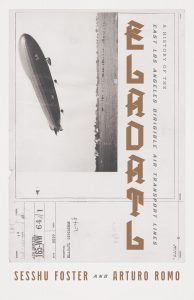
“ELADATL” will be released in April 2021 by City Lights.
Foster’s forthcoming novel, “ELADATL: A History of the East Los Angeles Dirigible Air Transport Lines,” experimentally creates a plot that is both fictional and factual, as well as incorporates photography and art to illustrate it.
Purposefully vague, Foster sought to tell the story of researchers investigating the history of a company that found its home in East LA and its impact on the community.
“It bears on gentrification in the sense that there are always these economic forces being brought to bear on vulnerable people on the Eastside in particular, and then those people are often displaced,” said Foster.
Preying on marginalized communities is an unfortunate trend his work highlights. Foster mentioned that many people might remember or know of the Battle of the Chavez Ravine in the 1950s when Dodger Stadium was built and the controversy surrounding that acquisition. Or equally as upsetting is the history of how and where most LA freeways were created — by plowing through entire East LA neighborhoods. These tragic events are something that has impacted the culture of the area and the lives of those who have lived and currently live there.
Something new to his latest book is Foster’s collaboration with local Lincoln Heights artist Arturo Romo. In “ELADATL,” Romo doctors historical photos to create mysterious illustrations that help the reader imagine the tale as a plausible history.
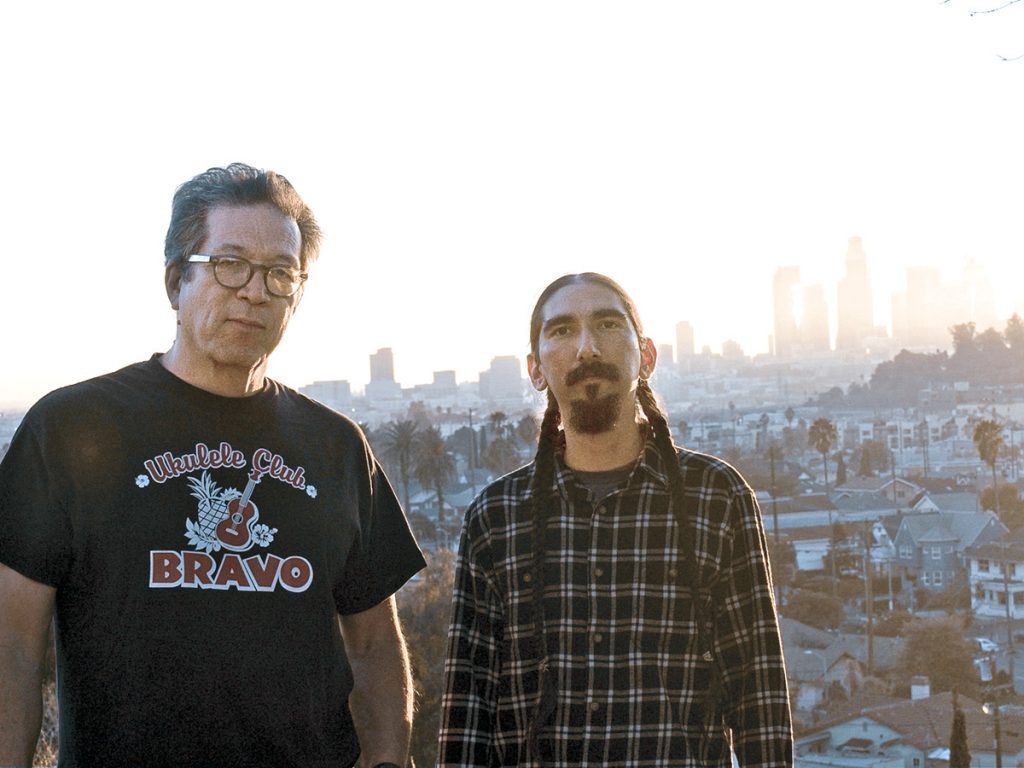
Sesshu Foster and artist Arturo Ernesto Romo, collaborator on the forthcoming book “ELADATL, a History of the East Los Angeles Dirigible Air Transport Lines” (City Lights Books, 2021)
The nondescript timeline and facts of the story allow readers to envision that these themes and happenings are a part of a cycle that not only exist in the past but also are currently plaguing our communities now.
For Foster, it is important that we know about and share the stories of “displacement, erasure, denial of community and denial of historical experience,” he said. He stated that these unfortunate events are “unspoken yet continuous.”
Thanks to creatives like Foster, we all can imagine local histories a bit clearer and hear the voices of the unheard. Foster continues to inspire us with his amazing passion for creativity and his heartfelt dedication to his community of East Los Angeles. So now, when someone mentions East LA, we hope you might now think of poetry, literature and art first.
Sesshu Foster’s latest novel, “ELADATL: A History of the East Los Angeles Dirigible Air Transport Lines,” will be released in April 2021 by City Lights. Visit http://www.citylights.com for more information.

